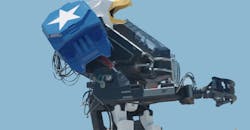In preparation for MegaBots' Eagle Prime squaring off with Suidobashi Heavy Industries' Kuratas, we caught up with the manufacturers whose roughest, toughest equipment is inside the giant fighting mech. Here's our interview with Dan Morgado, an applications engineer with actuator manufacturer Helac, acquired in May by Parker-Hannifin. When you see the 16-ft. bot's sweet uppercut during the soon-to-be-released fight video, now you'll know why it's so powerful.
NED: How did you get into contact with MegaBots?
DM: Our engineering dept reached out to Megabots via their Kickstarter campaign.
NED: What have you supplied to them?
DM: We sponsored MegaBots by providing 16 custom-designed Load-Bearing Hydraulic rotary actuators. The actuators are the powered-joints of the robots arms, wrists, elbows and shoulders. Helac actuators are unique in the industry as they provide tremendous output torque while also acting as the load-bearing joint. In other words they are hydraulic, "load-bearing" hinges that provide the needed range of motion and power for the robots arms.
NED: What technical aspects of your actuators make them the perfect choice for moving around these heavy robotic arms?
DM: The unique, inherent internal load-carrying capacity is made possible by journaling the actuator's radial bearings against the I.D. of the structural steel housing tubes. Large, oversize thrust washers provide exceptional axial capacity. The actuator shafts are essentially large diameter king-pins with integrated bolt flanges for direct attachment of heavy loads. This arrangement provides our customers with the most elegant simple and straightforward installations possible. By combining the huge output torque values with massive inherent radial and axial capacities, we simplify our customers' installations with minimal space claim while providing exceptional shock resistance; think super-high power density.
NED: How has your equipment used in manufacturing?
DM: Our actuators are live pivot points, also referred to as hydraulic hinges or "torque-transmitting" bearing assemblies. Because they have the ability to act as the bearing or superstructure while transmitting massive amounts of torque at the same time they are used as load-bearing steering assemblies on lift trucks, agricultural equipment, mining machinery, paving equipment just to name a few. They support and rotate boom-mounted aerial work platforms, rock drill assemblies, pipe handling and waste handling equipment as well as truck bed lifts on utility vehicles. In all of these applications zero-drift performance is enhanced by breakaway protection via pressure relief valves that are offered in optional dual counterbalance valve manifolds.
NED: What is the best part about working with MegaBots?
DM: Megabots is forging new ground with their development work on their amazing fighting robots. Eventually their work will provide the foundation for many industrial applications that we haven't even imagined yet. Participating in a project like this is exciting and quite a departure from typical mobile and industrial hydraulic applications; that's what makes it so fascinating and enjoyable.
Here's a taste of Eagle Prime's punching power, which was limited to 25% for the public display of force.
About the Author
John Hitch
Editor, Fleet Maintenance
John Hitch, based out of Cleveland, Ohio, is the editor of Fleet Maintenance, a B2B magazine that addresses the service needs for all commercial vehicle makes and models (Classes 1-8), ranging from shop management strategies to the latest tools to enhance uptime.
He previously wrote about equipment and fleet operations and management for FleetOwner, and prior to that, manufacturing and advanced technology for IndustryWeek and New Equipment Digest. He is an award-winning journalist and former sonar technician aboard a nuclear-powered submarine where he served honorably aboard the fast-attack submarine USS Oklahoma City (SSN-723).

